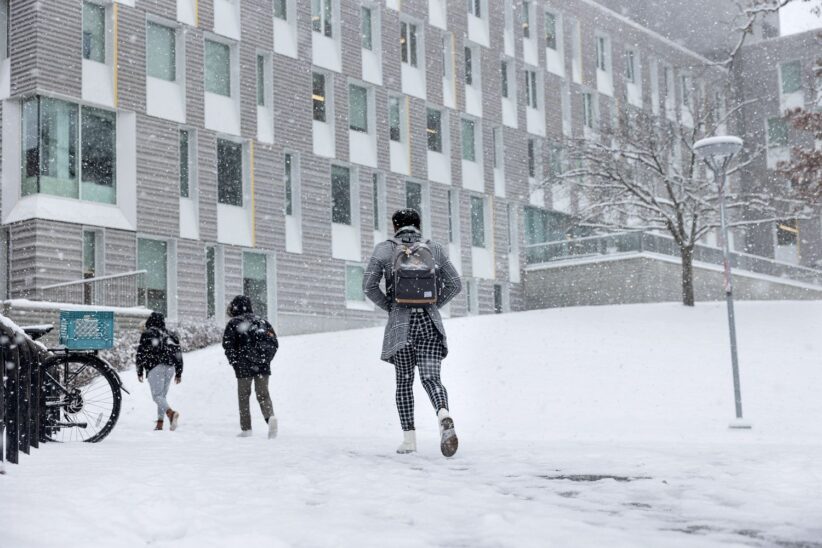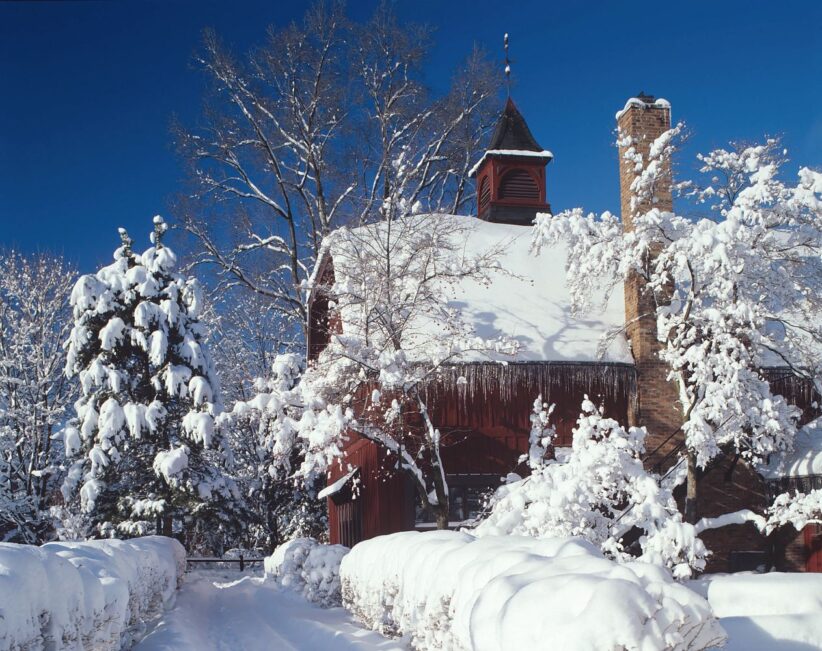Grad Tips: Winter Clothing Resources
November 3, 2025
By Katya Hrichak
As a graduate student, you have a lot to learn. Scholarship and research aside, there are many facets of the graduate school experience that are important to your success but might not be obvious or easy to figure out. Between achieving a sense of well-being, attending to basic needs, maintaining relationships or caring for others, etc., there’s a lot to keep track of.
The Graduate School is here to help. With the Grad Tips series, we’ll be providing insight into different aspects of the graduate student experience, sharing tips and advice on how to get the most out of your time at Cornell. To vote on the next topic in the series, check for a poll in upcoming issues of the Graduate School newsletter, News and Events.
This week’s topic: Winter clothing resources

Winters in Ithaca can be cold, snowy, and long, and it’s important to know how to dress to keep yourself safe and warm. Luckily, there are many resources and local places to find winter clothing to help keep you protected from the elements.
“The first winter can be really stressful for new students from warm climates, especially hearing how everyone in the area talks about winter. They really amp it up, and it feels like this really freaky thing, when the reality is that it’s not even so much the snow or cold, but the length and darkness that’s difficult,” said Olivia Hopewell, graduate student life advisor.
With the right winter gear, students have nothing to fear.
Why is it important to dress appropriately for winter?
Winter weather-related injuries can be severe, making dressing appropriately in cold weather a must. Frostbite, frostnip, hypothermia, and cold-induced asthma attacks are all risks associated with being unprepared for cold weather. Cornell Health’s Cold Weather Tips webpage offers descriptions of each of these conditions as well as the symptoms of frostbite. The National Weather Service provides a wind chill chart that provides guidance on temperature and wind chill exposure as they increase frostbite risk.
How do I dress appropriately for winter?
There are a number of steps you can take to prevent cold-related injury, and many resources you can consult for guidance.
Cornell Health recommends wearing layers of warm, loose-fitting clothing, a water-resistant jacket and boots, and covered hands and ears. The layers will keep moisture away from your skin, helping you to maintain body temperature, and the water-resistant outerwear will prevent heat loss.
International Services in the Office of Global Learning provides a list of student resources, including tips for Ithaca weather. In addition to advising students to dress in layers of loose clothing, the page advises investment in a good winter coat. Down jackets with outer nylon shells will keep you warmest by protecting you from the wind, but wool coats are good for winter weather as well. Wool or fleece socks will keep your feet warm, preferably inside boots with insulated lining and thick rubber soles. Hiking boots can work in place of winter boots, but rubber rain boots will likely not keep your feet warm enough, and leather boots will need to be waterproofed.
A chart from the National Weather Service, linked as a resource from Cornell’s Environment, Health and Safety Winter Safety page, provides specific guidance on how to dress for three winter temperature ranges: chilly, cold, and extreme cold.
- For chilly weather: One to two layers covering your torso; an outer layer to keep out wind and rain; a long layer over your legs; and warm, waterproof shoes
- For cold weather: Two to three layers covering your torso; an outer layer to keep out wind and wet snow; one to two layers over your legs; waterproof boots; a warm hat; and gloves
- For extremely cold weather: Three or more layers covering your torso, with one being an insulating layer; an outer layer to keep out wind; two or more layers over your legs; waterproof boots; a warm hat; gloves; and a face mask
Echoing this guidance, Hopewell encourages students to dress in layers, choose warmer natural fibers like wool over synthetics, and aim for waterproof materials. She acknowledges that this list of needed items can sound like a lot, but encourages students not to feel stressed.
“You don’t necessarily need everything all at once, and you don’t need the most expensive items,” she said. “You just need something that works for you and keeps you safe.”
Where can I find new winter clothing in Ithaca?
New winter clothing is available at a variety of price points across Ithaca. A few options for finding new gear include Dick’s Sporting Goods, Kohl’s, Old Navy, REI Co-op, Ross, Target, T.J. Maxx, and Walmart.
Where can I find used or inexpensive winter clothing?

Ithaca is home to many secondhand and thrift stores, including EverGreen Ithaca, Goodwill, Ithaca ReUse Center and MegaCenter, Mama Goose (for kids), Plato’s Closet, Salvation Army, and Thrifty Shopper.
“Secondhand, getting something from a friend, and clothing swaps are all great options,” said Hopewell.
Free clothing closets can also be good sources. Catholic Charities of Tompkins/Tioga and the Women’s Opportunity Center both offer such programs.
At Cornell, low-income students in need of winter clothing can apply to the Access Fund, administered by the Office of the Dean of Students through the Office of First-Generation and Low-Income Student Support. The Access Fund can provide up to $100 for winter boots or up to $150 for a winter attire set, including one coat, one hat, and one pair of gloves. Check the “What does the Access Fund cover?” section to learn more.
Where else can I find guidance on dressing properly for the winter?
Students new to the cold can ask peers further along in their programs, their graduate field administrators, their advisors, or individuals in campus offices for advice on what winter clothing items they find useful, where they have found their favorite winter gear, and what other tips they might have for staying warm during Ithaca winters.
“If a student doesn’t know what to do or hasn’t had experience with winter weather and they’re feeling lost, there are so many resources and so many people that can help figure out what they need,” said Hopewell. “Don’t hesitate to reach out and ask for help.”
